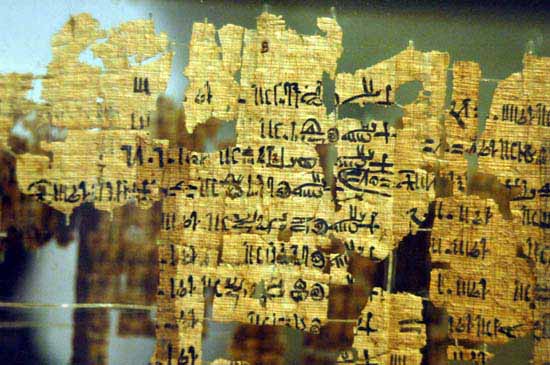
The Turin King List also known as the Turin Royal Canon, is a unique papyrus, written in hieratic, currently in the Museo Egizio (Egyptian Museum) at Turin, to which it owes its modern name.
The text dates to Ramesses II and mentions the names of all Egyptian rulers preceded by the register of gods that, as it was believed, ruled over Egypt before the Pharaonic era.
It is broken into over 160, often very small, fragments, many of which have been lost. When it was discovered in Thebes by the Italian traveller Bernardino Drovetti in 1822, it seems to have been largely intact, but by the time the King of Sardinia donated it to the collection of the Museo Egizio, its condition had severely deteriorated.
The importance of this papyrus was first recognized by the French Egyptologist Jean-François Champollion, who, later followed by Gustavus Seyffarth, took up its reconstruction and restoration.
Although they succeeded in placing most of the fragments in the correct order, the diligent intervention of these two men came too late and many pieces to this important papyrus still remain missing.
The papyrus, now 1.7m long and 0.41m high, comprises on the rear an unknown number of pages that hold a list of names of persons and institutions, along with what appears to be the tax-assessment of each.It is, however, the front of the papyrus that has attracted the most attention, as it contains a list of gods, demi-gods, spirits, mythical and human kings who ruled Egypt from the beginning of time presumably until the composition of this valuable document.
The beginning and ending of the list are now lost, which means that we are missing both the introduction of the list - if ever there was such an introduction - and the enumeration of the kings following the 17th Dynasty.
We therefore do not know for certain when, after the composition of the tax-list on the recto, an unknown scribe used the verso to write down this list of kings.
This may have occurred during the reign of Ramesses II, but a date as late as the 20th Dynasty can not be excluded.
The fact that the list was scribbled on the back of an older papyrus may indicate that it was of no great importance to the writer.We are also left in the dark as to what source or sources our scribe used to write down the list.
Did he simply copy an already existing papyrus, or did the scribe, probably having access to the archives of the temples, compile the list himself, using ancient tax-notes, decrees and documents?
The latter possibility seems the less likely and would imply that the Turin King List is indeed a unique document.
The papyrus gives the names of rulers, in some cases grouping them together and giving lengths of regency for some of these groups, which generally correspond to the dynasties of Manetho's outline.
Moreover, it shows in years, months and days the duration of ruling for individual kings.
It also includes the names of ephemeral rulers or those ruling over small territories and, as such, are barely known nowadays, being usually unmentioned in other sources.
The list includes the Hyksos rulers (often left out of other King Lists), although they were not given cartouches, and a hieroglyphic sign was added to indicate that they were foreigners.




0 comments:
Post a Comment